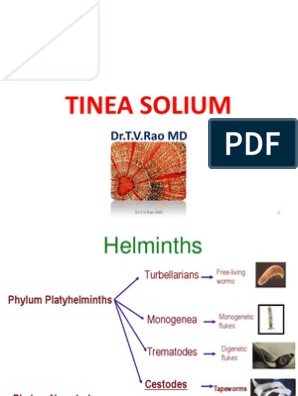0% found this document useful (0 votes)
63 views5 pagesCestodes Table
This document provides information on different types of cestodes (tapeworms), including their common names, the diseases they cause, geographical distribution, key morphological features, and life cycles. Some of the main tapeworms discussed are Diphyllobothrium latum (fish tapeworm), Taenia solium (pork tapeworm), Taenia saginata (beef tapeworm), Echinococcus granulosus (hydatid tapeworm), Hymenolepis nana (dwarf tapeworm), and Dipylidium caninum (double-pored tapeworm of dogs).
Uploaded by
Eiveren Mae SutillezaCopyright
© © All Rights Reserved
We take content rights seriously. If you suspect this is your content, claim it here.
Available Formats
Download as PDF, TXT or read online on Scribd
0% found this document useful (0 votes)
63 views5 pagesCestodes Table
This document provides information on different types of cestodes (tapeworms), including their common names, the diseases they cause, geographical distribution, key morphological features, and life cycles. Some of the main tapeworms discussed are Diphyllobothrium latum (fish tapeworm), Taenia solium (pork tapeworm), Taenia saginata (beef tapeworm), Echinococcus granulosus (hydatid tapeworm), Hymenolepis nana (dwarf tapeworm), and Dipylidium caninum (double-pored tapeworm of dogs).
Uploaded by
Eiveren Mae SutillezaCopyright
© © All Rights Reserved
We take content rights seriously. If you suspect this is your content, claim it here.
Available Formats
Download as PDF, TXT or read online on Scribd
/ 5






















































































